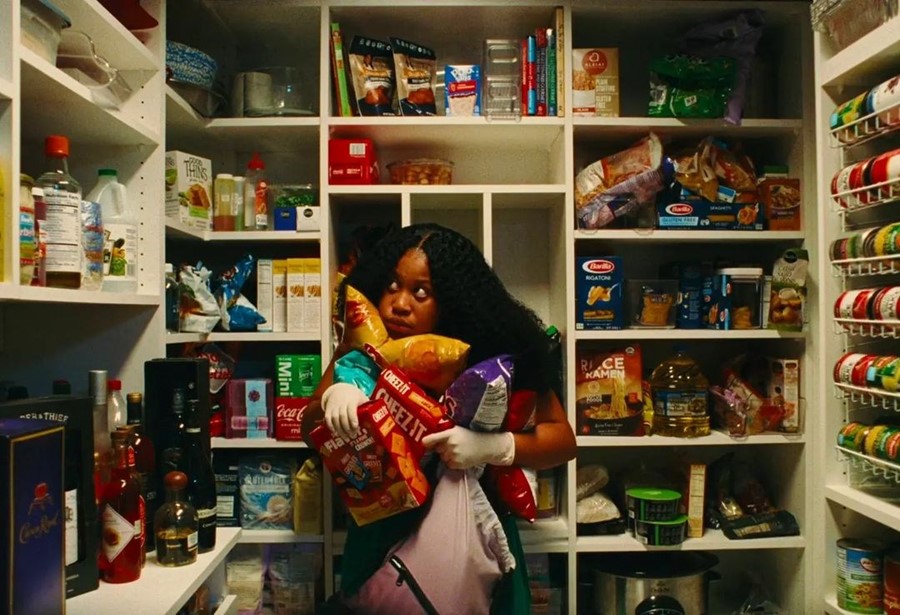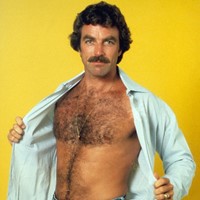Filled with cannibals, vampires and murderers who devour and indulge to the point of excess, the horror genre allows women to be free from restriction and appetite suppression
“Why be miserable when you can just have lemon cake?”
So says Rashida’s mom, Jackie (Cree Summer), in the last episode of Janine Nabers and Donald Glover’s hit horror series Swarm. In the episode, serial killer Dre (Dominique Fishback) is on to her latest and last alias, now identifying as a masculine-presenting woman named Tony. She meets her girlfriend Rashida’s (Kiersey Clemons) parents for the first time, and they all have dinner together. While the audience is witnessing a radically different side to Dre, the setting is one we are very familiar with in Swarm, with the characters frequently eating together or by themselves.
Dre eats after most of her murders. She eats a pie after her first murder, a sandwich after her second and steals a significant amount of junk food from the home of her third victim. When a man asks to jerk off to Dre in episode two (who at this point was identifying as a stripper), she agrees but tells him, “I’m still gonna eat.” As promised, she continues to eat her pretzels while he masturbates to her body, completely unbothered. When Dre isn’t eating alone, she’s asked by others to eat with them. In episode two, Dre is asked out to lunch by Hailey (Paris Jackson); in episode four, Dre is invited to have lunch with Eva (Billie Eilish) and her cult; and in episode five, Marissa’s (Chloe Bailey) old boss asks Dre to have lunch with her so they can catch up after Marissa’s death. The characters in Swarm eat food with an ease that feels unfamiliar in our society.
I can’t remember the last time I had uncomplicated thoughts about food. When I was seven or eight years old, my mum gave me the responsibility of making dinner for my siblings a few times a week. While she ranted about the importance of learning to cook for oneself, her statement was undermined by her reminder that I also needed to learn how to cook so I could one day become a good wife and mother. As a result, my future domestic life loomed large over my head like a dark cloud, taking the satisfaction straight out of making and eating food during my childhood. When I was a teenager, my mum and her friends became involved in WeightWatchers. During that time, I learned that food wasn’t just my gendered responsibility as a “woman” but something that I had to be wary of, restrict or outright ignore in order to fit into my socially determined gender role, marked by thinness and self-discipline.
For so many of us, food isn’t just a substance we consume for nourishment and fuel. Instead, it’s become a site of anxiety and guilt as we strive for the promise of happiness we are taught skinniness provides. Last year, the NHS announced that they are treating more young people with eating disorders than ever before, with the cost of living crisis exacerbating the issue. Additionally, the appetite-suppressing Ozempic is the word on everyone’s lips after its New York Magazine cover story titled ‘Life After Food’. While fatphobia continues to run rife in our society, the horror genre can often be a safe haven from our diet-obsessed culture, acting as a space where contemporary ideas about food, gender and the body continue to be denounced and challenged.
The horror genre is one of “abundance – and food is the perfect metaphor in its narratives because it holds so many meanings at once,” Laura Maw wrote in an article titled “There’s Nothing Scarier Than a Hungry Woman”. The suppression of one’s appetite is rarely depicted in these pieces of media, with narratives filled with cannibals, vampires and zombies who devour and indulge to the point of excess. One of the first things Megan Fox’s character does after being possessed by a demon in Jennifer’s Body is ransack Needy’s fridge. She later moves on, famously, to eating boys.
Last year’s Bones and All begins with cannibal Maren (Taylor Russell) sneaking out of her house to attend a sleepover with the girls from her school. Maren lays down beside one of her classmates, completely intoxicated by her scent. While her classmate attempts to ask her questions, Maren can barely pay attention to her. She is, instead, completely fixated on her need to feed. When her classmate shows her their nail polish and asks for her opinion, Maren can’t control herself. She looks at her classmates’ fingers sensually and then devours them without a second thought. Unlike so many of us who are traumatised by diet culture, Maren listens to her bodily urges even though she knows it will land her in trouble.
Horror narratives about murderous or morally dubious women make a particular point of rejecting the traditional “politics of feminine food denial”. In BBC America’s Killing Eve (which is not a horror but uses similar tropes), the central female characters are known for their rapacious appetites, often consuming foods seen as improper for the maintenance of the ‘conventional’ feminine body, such as meat. In episode four of season one, Eve (Sandra Oh) and Carolyn (Fiona Shaw) meet in a butcher shop as they believe they’ve discovered a mole in their team who played a hand in the death of Eve’s partner Bill. At the end of their conversation, Carolyn urges Eve to “stay nourished” and “get some chops” before leaving the butcher shop with what looks like a dinosaur-sized bone of meat. During a time of mourning, the bereaved naturally engage in a form of fasting. Instead of engaging in this type of mourning, often coded as feminine, Eve and Carolyn refuse to downplay their appetites.
Female horror characters often embody society’s fears about women. Cultural critic Peter Biskind described The Exorcist as being “a male nightmare of female puberty. Emergent female sexuality is equated with demonic possession.” As Maw noted, women indulging their appetites and desires is monstrous to society. Being a woman is all about self-abnegation, we live to fulfil the desires of others rather than our own. We change ourselves and our bodies, making them smaller in every context through dieting and cosmetic surgery, through moving out of the way on the street and not taking up space. We apologise and deny our basic needs. We’ve grown up receiving messages about what it means to be a “good girl”, and in turn, we bend ourselves backwards to meet impossible standards set by others.

But these narratives filled with monstrous women showcase individuals who are allowed to enact their own desires, who quench their own thirsts and satisfy their own hunger in ways that so many of us have always longed to do. I’d be lying if I said I didn’t find personal empowerment within these narratives and, as a result, my eating habits and behaviour started to change. Instead of shaming myself when I found that I had overeaten, I decided to revel in the feeling of fullness that transpired in my stomach – knowing that I’ll now have enough energy to get through the morning.
Of course, there are problems. The women leading these narratives are still skinny and conventionally attractive. Moreover, it’s incredibly frustrating that these narratives feel ‘radical’ and ‘empowering’ to many of us because we live in a culture that normalises starvation; that shames and berates people for responding to their normal bodily urges. In Naomi Wolff’s seminal text The Beauty Myth, she writes that “women feel guilty about female fat because we implicitly recognise that under the myth, women’s bodies are not our own but society’s.” What I love about the horror genre and these narratives is that they remind us that our bodies are our own. We do not have to live as society dictates, no matter how truly horrifying that may be to others.




